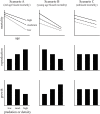Population Variation in the Life History of a Land Fish, Alticus arnoldorum, and the Effects of Predation and Density
- PMID: 26398191
- PMCID: PMC4580579
- DOI: 10.1371/journal.pone.0137244
Population Variation in the Life History of a Land Fish, Alticus arnoldorum, and the Effects of Predation and Density
Abstract
Life history variation can often reflect differences in age-specific mortality within populations, with the general expectation that reproduction should be shifted away from ages experiencing increased mortality. Investigators of life history in vertebrates frequently focus on the impact of predation, but there is increasing evidence that predation may have unexpected impacts on population density that in turn prompt unexpected changes in life history. There are also other reasons why density might impact life history independently of predation or mortality more generally. We investigated the consequences of predation and density on life history variation among populations of the Pacific leaping blenny, Alticus arnoldorum. This fish from the island of Guam spends its adult life out of the water on rocks in the splash zone, where it is vulnerable to predation and can be expected to be sensitive to changes in population density that impact resource availability. We found populations invested more in reproduction as predation decreased, while growth rate varied primarily in response to population density. These differences in life history among populations are likely plastic given the extensive gene flow among populations revealed by a previous study. The influence of predation and density on life history was unlikely to have operated independently of each other, with predation rate tending to be associated with reduced population densities. Taken together, our results suggest predation and density can have complex influences on life history, and that plastic life history traits could allow populations to persist in new or rapidly changing environments.
Conflict of interest statement
Figures





Similar articles
-
How populations differentiate despite gene flow: sexual and natural selection drive phenotypic divergence within a land fish, the Pacific leaping blenny.BMC Evol Biol. 2014 May 6;14:97. doi: 10.1186/1471-2148-14-97. BMC Evol Biol. 2014. PMID: 24884492 Free PMC article.
-
Phenotypic diversification across an environmental gradient: a role for predators and resource availability on the evolution of life histories.Evolution. 2009 Dec;63(12):3201-13. doi: 10.1111/j.1558-5646.2009.00785.x. Epub 2009 Jul 28. Evolution. 2009. PMID: 19656183
-
Variation in predation pressure as a mechanism underlying differences in numerical abundance between populations of the poeciliid fish Heterandria formosa.Oecologia. 2006 Apr;147(4):596-605. doi: 10.1007/s00442-005-0306-y. Epub 2005 Dec 10. Oecologia. 2006. PMID: 16341890
-
How detectable is predation in stage-structured populations? Insights from a simulation-testing analysis.J Anim Ecol. 2015 Jan;84(1):60-70. doi: 10.1111/1365-2656.12274. Epub 2014 Aug 16. J Anim Ecol. 2015. PMID: 25056097
-
Predation on dependent offspring: a review of the consequences for mean expression and phenotypic plasticity in avian life history traits.Ann N Y Acad Sci. 2009 Jun;1168:201-17. doi: 10.1111/j.1749-6632.2009.04577.x. Ann N Y Acad Sci. 2009. PMID: 19566709 Review.
Cited by
-
Land colonisation by fish is associated with predictable changes in life history.Oecologia. 2016 Jul;181(3):769-81. doi: 10.1007/s00442-016-3593-6. Epub 2016 Mar 1. Oecologia. 2016. PMID: 26932469
-
Reproductive life-history strategies in a species-rich assemblage of Amazonian electric fishes.PLoS One. 2019 Dec 5;14(12):e0226095. doi: 10.1371/journal.pone.0226095. eCollection 2019. PLoS One. 2019. PMID: 31805125 Free PMC article.
References
-
- Stearns SC. (1992). The evolution of life histories. Oxford University Press, Oxford.
-
- Zera AJ, Harshman LG. (2001). The physiology of life history trade-offs in animals. Ann. Rev. Ecol. Syst. 32, 95–126.
-
- Michod RE. (1979). Evolution of life histories in response to age-specific mortality factors. Am. Nat. 113, 531–550.
-
- Hutchings JA. (1993). Adaptive life histories effected by age-specific survival and growth rate. Ecology 74, 673–684.
Publication types
MeSH terms
LinkOut - more resources
Full Text Sources
Other Literature Sources

